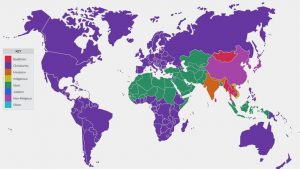I remember in high school history classes that often, when presented with a chart of population expansion or a similar idea in the textbook, the teacher would instead play a YouTube video that showed the same idea with movement and color. That’s what I thought of while I read these selections—how multimodal digital publishing can make this kind of demonstration more accessible (continued below images….)

A map of the spread of world religions, static, as compared to the video (below) that I remember from tenth grade, which is more engaging and more clear.
That is one of the advantages of digital over print publishing—digital publishing has access to videos and sound, and can combine these with words and images to extend understanding (Arola 12). Print, too, can do this to an extent—I think of the Dragonology book I had as a kid, with pull out maps, samples of “dragon skin” to touch, and “old documents” folded in among the pages.
But digital texts can use different elements to a different end, one beyond convenience: Arola says that “multimodal composition allows us to become makers of our social futures” and adds that “writer/designers can communicate in more globally aware, digitally driven, ethical, and accessible ways” (6). She says that even using an image can speak across languages, although Kress, in “Where Meaning Is The Issue”, points out how modes of communication differ from culture to culture, and how gestures or appearances could be understood differently from place to place—“what about a translation of a movement, an action, a gesture that is entirely understood in one society and either entirely misunderstood or not understood in any way in another?” (11) he says, when writing about movie subtitles.
Kress adds that he takes “‘multimodality’ as the normal state of human communication” (1), noting how human social conventions include facial expressions, gestures, speech, and more, which I thought was particularly striking. These multimodal methods of communication line up with the modes Arola uses—linguistic, visual, aural, spatial, and gestural—and which she says need to be incorporated into a text “so that readers with limited vision, hearing, or touch—among other possible differences within an audience—can still interact with a text” (20). I think this speaks to what Kress says of human communication, where all of the different forms are used, and can reach people who share at least the understanding of that culture. Multimedia publishing replicates that on the screen—opening up as many methods of access as possible.
Word Count: 390
Works Cited:
Arola, Kristin L., et al. Writer/Designer: A Guide to Making Multimodal Projects. Bedford/St. Martin’s, 2014.
Kress, Gunther. “Where Meaning is the Issue.” Multimodality. 1-17.
Mactavish, Andrew and Geoffrey Rockwell. “Multimedia.” A Companion to Digital Humanities.